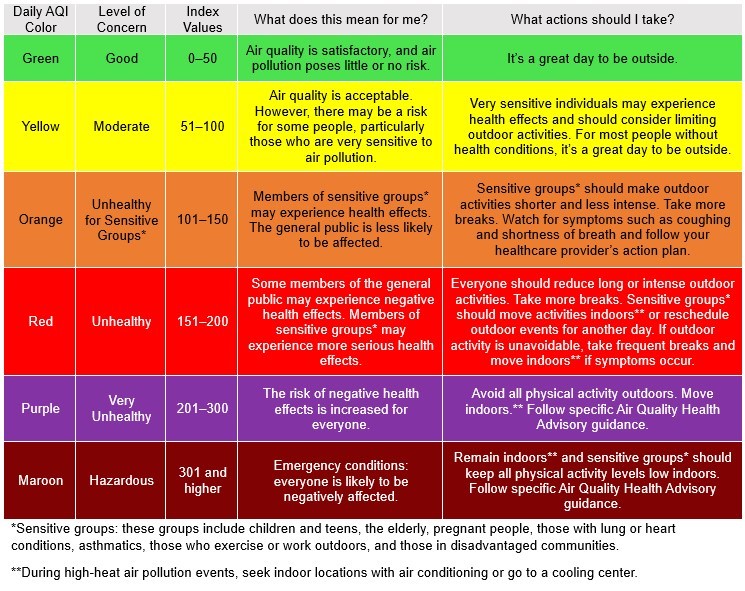Understanding Air Quality Advisories
After a brief period of unseasonably dry weather and below-average temperatures this month, less pleasant conditions have returned for the last week of August. While many may be focused on the elevated temperatures and higher humidity levels predicted in local weather forecasts, people should also be aware of air quality conditions. The levels of ozone and particulate matter in the air are tracked by the New York State Department of Environmental Conservation (DEC) and the New York State Department of Health (DOH) as indicators of air pollution.
What Is the Air Quality Index?
The Air Quality Index (AQI) scale developed by the United States Environmental Protection Agency (EPA) is used to express the level of health concern related to air pollutants. The AQI consists of six categories ranging from “good” (green, AQI less than or equal to 50) to “hazardous” (maroon, AQI greater than or equal to 301). The below table from EPA explains the AQI in full.
Higher AQI values correspond to worsening air quality conditions which are a concern to the elderly and individuals dealing with respiratory problems, cardiovascular trouble, and other health issues. Health advisories are issued to alert sensitive populations to limit outdoor activities when the AQI is 101 or above, indicating air quality is unhealthy for sensitive groups.
How Can I Determine the AQI?
DEC’s AQI forecast can be accessed at https://extapps.dec.ny.gov/cfmx/extapps/aqi/aqi_forecast.cfm. With this week’s blast of high temperatures and humidity, the AQI in certain areas is hovering around 100. This means that even though air quality is still considered to be acceptable, those who are inclined to be sensitive to air pollution may be impacted. It is important to pay attention to the AQI so you and those around you are prepared to adjust activities as needed to avoid adverse effects.
How Can I Contribute to Better Air Quality?
The DEC issued advisories in July 2024 related to high concentrations of ground-level ozone, a major contributor to smog. Ozone is generated by human-made sources combined with heat and sunlight. Industrial facilities and automobile exhausts are significant sources of ground-level ozone, and high temperatures exacerbate ozone formation. High levels of ozone in the air can affect one’s health and cause respiratory and cardiovascular-related ailments.
Making modest changes in day-to-day activities can help limit the amount of ozone and other pollutants in the air. Several recommendations are listed below:
- Limit electrical usage by turning off appliances not in use and setting house air conditioner temperature to 78 degrees
- Avoid outdoor burning activities (campfires, burning of garbage)
- Take public transportation or carpool with others to reduce vehicle emissions
- Purchase energy efficient appliances and lighting
Contact Walden at 516-588-6859 and speak to one of our experienced air pollution engineers to learn more about the AQI and actions you can take to help improve air quality in your community.

Photo by Oscar Portan: https://www.pexels.com/photo/cars-on-the-road-of-new-york-10086616/
Walden’s experienced engineers can help you with a wide range of air quality issues. Contact us at 516-588-6859 today!

